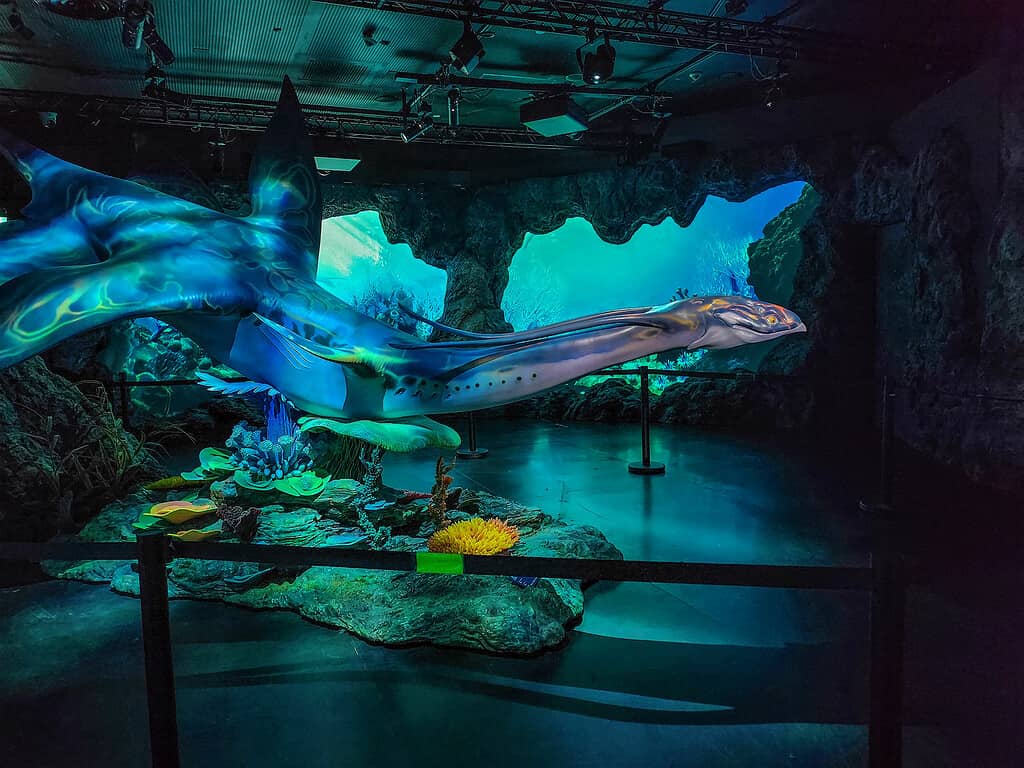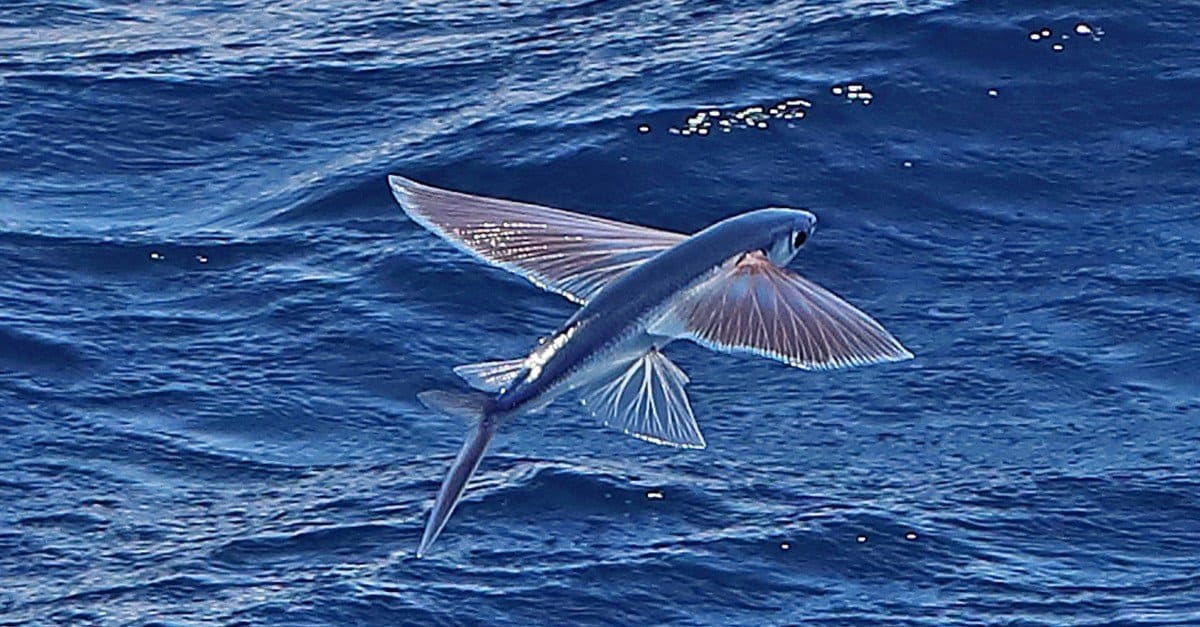The Avatar universe is known to showcase a plethora of unique life forms. The original film broke the barriers of digital animation when it created a universe of beautiful landscapes and lifeforms, and the sequel is no exception.
Avatar 2: The Way of Water, which was recently released in 2022, presents the same beloved creatures from the original film while expanding the universe with even more life. In the new movie, we dive below the sea to explore the underwater aspects of Pandora and are introduced to many of the new one-of-a-kind marine animals that come along with it.
Animal In Avatar 2: Banshee (Ikran)

©DerekTeo/Shutterstock.com
There are two subspecies of Banshee: the Mountain Banshee and the Forest Banshee. They differ in size, color, and importance to the Na’vi.
Mountain Banshee
The Mountain Banshees are used for air travel, hunting, and battle by the Na’vi. The Banshee’s bones are light and strong due to their biologically produced carbon fiber skeleton.
Banshees look similar to reptiles and are almost dragon-like with leathery skin. Their skin can be varied in color from indigo to shades of red. Adult Banshees are typically 15-20 feet long with a wing span of around 45 feet! This is comparable to a small propellor plane!
Their metabolism generates heat similar to that of birds. Birds are homeotherms and can maintain internal body temperature by generating their own heat and cooling themselves off through involuntary processes.
Birds trap pockets of air around their body using their feathers. This allows them to warm themselves even more during cold weather. Banshees have air inlets to cool them off on their chest. These flap-like inlets allow cool air to reach their skin and cool them off in flight. They have two primary eyes that have full-color vision as well as a smaller set of secondary eyes. The secondary eyes have an infrared vision that allows them to see well in the dark. Banshees’ wings have a claw that helps them climb cliffs and walk on the ground.
These creatures are carnivorous and prey on smaller fictional Pandorean animals such as Hexapodes, Prolemuris, and Stingbats. Their only predator is the Great Leonopteryx (Toruk), which is an even larger dragon-like creature. Na’vi warriors bond with a Banshee using their kuru and are able to connect with them and directly control them through their thoughts.
Forest Banshee
The Forest Banshees are much smaller than the Mountain Banshees and, therefore, incapable of supporting a Na’vi rider. Their wingspan is 22 feet long, almost half the size of the Mountain Banshee. They are solitary hunters that generally don’t attack anything close to their size unless they need to defend themselves. Their typical prey includes Stingbats and Prolemuris. The Forest Banshees are multicolored with translucent winged membranes. They share most of their anatomical characteristics with the Mountain Banshee, such as their carbon-fiber bones and ability to heat and cool themselves.
Animal In Avatar 2: Hammerhead Titanothere (Angtsìk)
The average adult Hammerhead Titanothere is 35 feet long and 20 feet tall, or around double the size of an earth elephant. Their skin is blue over most of their body but light brown or gray on their legs. Titanotheres are herbivorous, meaning they feed and gain energy exclusively from plant matter. They possess four eyes that are a yellow-orange color. Their eyesight is substandard, but their other senses are heightened. They have an excellent sense of hearing and smell.
Titanotheres have bony plates that serve as armor but only protect the front of their bodies. They also have small scent organs on their necks and beak-like jaws.
They are called “Hammerhead” due to the cartilaginous structure on their head. This structure appears when they are young but becomes calcified bone when they are fully grown. On top of the hammerhead structure is a colorful crest that they raise either when they are in combat or attempting to attract a mate. The Hammerhead Titanothere are social animals that travel in packs of up to 20 animals. They are very territorial and will raise their colorful crest when defending themselves from adversaries.
Direhorse (Pa’li)
Direhorses are nectarivorous, meaning their food source is restricted to nectar produced by plants. They have an extra long snout with a tongue specifically designed to suck the nectar out of the pitcher plant. This adaptation is very similar to that of a hummingbird. They are horse-like creatures that have long necks and relatively small heads. Direhorses grow up to 14 feet in length and are 13 feet tall, more than double the size of a normal horse.
Direhorses have six legs that allow them to make quick turns and fast movements. These creatures serve as a mode of transportation for the Na’vi and are used during hunting and battle. To tame a dire horse, the rider must form a neural bond or a “tsaheylu” with the animal. After this bond is completed, the dire horse becomes under the rider’s control and is essentially an extension of their own body. These neural links do not last forever; a dire horse is not exclusively bonded to one rider.
Animal In Avatar 2: Great Leonopteryx (Toruk)
The Na’vi name for the Great Leonopteryx is “Toruk,” which translates to “last shadow.” They were named for this due to their method of attack from above and their shadow being the last thing their victim will ever see.
The Great Leonopteryx is the apex predator of the Pandoran skies and the only thing that preys on the Banshee. The Leonopteryx is hypercarnivorous, meaning its diet comprises more than 70% meat. Their prey of choice is the Mountain and the Forest Banshee. The Leonopteryx is a solitary animal, spending most of its time alone as opposed to in a group. Biologically, the Leonopteryx is a relative of the Banshee. It has large wings that have claws on the end of them. Similar to the Banshee, the Leonopteryx has carbon fiber bones that allow for increased speed and strength.
Toruk also has a sharp crest on the top of its head that is used to injure prey or clear a path during flight. Unlike Banshees, the Great Leonopteryx has six limbs used while on the ground and to grab and injure prey while in flight. It has four yellow eyes, two in the front and two on the side of its head. With a wingspan of 80 to 100 feet, it almost doubles the size of the Banshee and nearly the size of a passenger jet!
These creatures most closely resemble a mythical dragon with aspects of earthly animals. The wings of a “Toruk” are similar in structure to a bird.
Animal In Avatar 2: Thanator (Palulukan)
Thanators are the apex land predator on Pandora. They have dark purple skin, almost appearing black and are similar in appearance to a panther. The Thanator is very territorial and fiercely guards its range of approximately 300 square miles within the Pandora jungle. This creature is a carnivore that solitarily hunts at night within its territorial range. On average, they are 8 feet tall and more than 18 feet long (head to tail).
The Thanator most resembles a feline creature and is known to run and leap on prey before tearing them apart. It also has a heavy, reinforced tail capable of landing a lethal blow. They use their tail to defend themselves against other Thanators. The creature also has hypersensitive quills that protrude from the back of its skull; the exact use of these is still unknown, but likely to locate prey and give them a more threatening presence.
The neck and back of the Thanator are heavily armored with their thick, protective skin. Thanators have long sharp teeth that are up to 9 inches long and fold back their upper lip.
Ilu

©mastapiece/Shutterstock.com
Ilu were newly introduced in Avatar 2 movie. The Ilu is a water-dwelling Pandorean creature that is similar to the extinct plesiosaur and the modern-day dolphin. The Ilu ranges from 6 to 50 feet in length. The skin on its back is black with colorful patches, while the skin on its stomach is white. It has six flippers and a long neck, similar to that of a plesiosaur. The Ilu breathes air like a dolphin and is highly sociable and intelligent.
This animal has a similar body to that of a manta ray by the way it flexibly swims through the water. The Ilu has four orange eyes and two sensory antennas that extend from its head. They are known as the Direhorse of the oceans in Pandora, as the Na’vi bond with them and ride on their backs for transportation and battle.
Animal In Avatar 2: Skimwing (tsurak)
Another newly introduced creature, Skimwings, inhabits the tropical oceans in Pandora. They have gray and orange skin on their body as well as their fins. Skimwings can grow to more than 50 feet long and live for an average of 20 years. They are most similar to flying fish as they partially raise their bodies from the water using their large fins as wings. These are the primary war mounts for water-dwelling Na’vi people.
Na’vi ride on their backs as they travel 58 miles per hour through the water. They breathe in two different ways. They can use their gills when underwater, and they can breathe using their nostrils located on the top of their heads while they fly. Only the most skilled Metkyina hunters are able to tame and form a bond with a Skimwing.
Animal In Avatar 2: Tulkin
The Tulkin are large marine mammals in Pandora that can be up to 300 feet long. Or as long as a 25-story building! The Tulkin is most similar to real-world whales, as they are highly emotional and intelligent creatures. Also similar to whales, they are filter feeders, presumably through the baleen, that filter the water in their mouths. Tulkins are black, blue, and white and have red on the crest at the top of their head.
They have their own complex language and can even communicate with the Na’vi. These hyper-intelligent creatures are thought to be even smarter than humans in The Way Of Water. They are hunted by humans for a valuable serum called “amrita” located in their brains that can be used to halt the aging process. This practice is similar to the hunting of sperm whales for oil.
The Tulkin are the largest creature introduced to us on Pandora (thus far). Like many other Pandoran creatures, Tulkin have four orange eyes, two on either side of their head. They also have six flipper fins, the lower two fusing to form the tail. Similar to whales, they breathe using a blow hole but have six holes instead of one or two. They can swim up to 25 miles per hour and live for an average of 200 years.
Thank you for reading! Have some feedback for us? Contact the AZ Animals editorial team.








